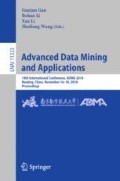Abstract
The previous low-rank matrix recovery model for saliency detection have a large of problem that the transform matrix obtained on the open datasets may not be suitable for the detecting image and the transform matrix fails to combine the low-level features of the image. In this paper, we propose a novel salient object detection model that combines sparse and low-rank matrix recovery (SLRR) with the adaptive background template. Our SLRR model using a selection strategy is presented to establish the adaptive background template by removing the potential saliency super pixels from the image border regions, and the background template is obtained. And the sparse and low rank matrix recovery model solved by Inexact Augmented Lagrange Multiplier (ALM). Both quantitative and qualitative experimental results on two challenging datasets show competitive results as compared with other state-of-the-art methods. In addition, a new datasets which saliency object on the edge (SOE), containing 500 images is constructed for evaluating saliency detection.
Access this chapter
Tax calculation will be finalised at checkout
Purchases are for personal use only
References
Borji, A., Cheng, M.M., Jiang, H., et al.: Salient object detection: a benchmark. IEEE Trans. Image Process. 24(12), 5706–5722 (2015)
Yuan, Y., Li, C., Kim, J., et al.: Reversion correction and regularized random walk ranking for saliency detection. IEEE Trans. Image Process. 27(3), 1311–1322 (2018)
Li, X., Lu, H., Zhang, L.: Saliency detection via dense and sparse reconstruction. In: Proceedings of the 2013 IEEE International Conference on Computer Vision (ICCV), pp. 2976–2983. IEEE, Sydney (2013)
Wang, K., Lin, L., Lu, J., Li, C., Shi, K.: PISA: pixelwise image saliency by aggregating complementary appearance contrast measures with edge-preserving coherence. IEEE Trans. Image Process. 24(10), 3019–3033 (2015)
Wang, L., Lu, H., Ruan, X., Yang, M.H.:Deep networks for saliency detection via local estimation and global search. In: Proceedings of the 2015 IEEE Conference on Computer Vision and Pattern Recognition (CVPR). pp. 3183–3192. IEEE, Boston (2015)
Chen, W., et al.: EEG-based motion intention recognition via multi-task RNNs. In: Proceedings of the 2018 SIAM International Conference on Data Mining, pp. 279–287. Society for Industrial and Applied Mathematics (2018)
Li, X., Lu, H., Zhang, L., Ruan, X.: Saliency detection via dense and sparse reconstruction. In: Proceedings of the IEEE International Conference on Computer Vision, pp. 2976–2983. IEEE, Sydney (2013)
Jain, S.D., Grauman K.: Active image segmentation propagation. In: Proceedings of the IEEE Conference on Computer Vision and Pattern Recognition (CVPR), pp. 2864–2873. IEEE, Nevada (2016)
Yu, G., Yuan, J., Liu, Z.: Propagative Hough voting for human activity detection and recognition. IEEE Trans. Circuits Syst. Video Technol. 25(1), 87–98 (2015)
Yue Lin, Weitong Chen, Xue Li, Wanli Zuo, and Minghao Yin.: A survey of sentiment analysis in social media. Knowl. Inf. Syst. 1–47 (2018)
Horbert, E., García, G.M., Frintrop, S., Leibe, B.: Sequence level object candidates based on saliency for generic object recognition on mobile systems. In: Proceedings of 2015 IEEE International Conference on Robotics and Automation (ICRA), pp. 127–134. IEEE, Washington (2015)
Yang, X., Qian, X., Xue, Y.: Scalable mobile image retrieval by exploring contextual saliency. IEEE Trans. Image Process. 24(6), 1709–1721 (2015)
Lei, B., Tan, E.L., Chen, S., Ni, D., Wang, T.: Saliency-driven image classification method based on histogram mining and image score. Pattern Recognit. 48(8), 2567–2580 (2015)
Chandra S, Usunier N, Kokkinos I.:Dense and low-rank Gaussian CRFs using deep embeddings[C]//International Conference on Computer Vision (ICCV), pp. 5113–5122. IEEE, Venice (2017)
Yao, X., Han, J., Zhang, D., et al.: Revisiting co-saliency detection: a novel approach based on two-stage multi-view spectral rotation co-clustering. IEEE Trans. Image Process. 26(7), 3196–3209 (2017)
Jiang, B., Zhang, L., Lu, H., Yang, C., Yang, M.H.: Saliency detection via absorbing Markov chain. In: Proceedings of the 2013 IEEE International Conference on Computer Vision (ICCV), pp. 1665–1672. IEEE, Sydney (2013)
Lu, H., Li, X., Zhang, L., Ruan, X., Yang, M.H.: Dense and sparse reconstruction error based saliency descriptor. IEEE Trans. Image Process. 25(4), 1592–1603 (2016)
Ishikura, K., Kurita, N., Chandler, D.M., et al.: Saliency detection based on multiscale extrema of local perceptual color differences. IEEE Trans. Image Process. 27(2), 703–717 (2018)
Acknowledgement
This paper is supported by the Fundamental Research Funds for the Central Universities (NS 2015092).
Author information
Authors and Affiliations
Corresponding author
Editor information
Editors and Affiliations
Rights and permissions
Copyright information
© 2018 Springer Nature Switzerland AG
About this paper
Cite this paper
Wang, C., Li, J., Li, K., Zhuang, Y. (2018). A Sparse and Low-Rank Matrix Recovery Model for Saliency Detection. In: Gan, G., Li, B., Li, X., Wang, S. (eds) Advanced Data Mining and Applications. ADMA 2018. Lecture Notes in Computer Science(), vol 11323. Springer, Cham. https://doi.org/10.1007/978-3-030-05090-0_11
Download citation
DOI: https://doi.org/10.1007/978-3-030-05090-0_11
Published:
Publisher Name: Springer, Cham
Print ISBN: 978-3-030-05089-4
Online ISBN: 978-3-030-05090-0
eBook Packages: Computer ScienceComputer Science (R0)

